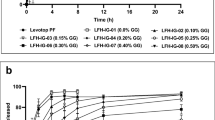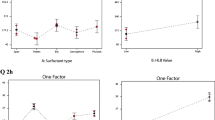Abstract
The aim of the present study was to develop thermosensitive emulsomal in situ gel for ocular delivery of sparfloxacin, an antibacterial drug. The study was conducted in two steps. In the first step, sparfloxacin emulsomes were prepared by thin film hydration technique and characterized. Compritol 888 ATO (CA) was used as lipid core and Phospholipon 90G (PC) as stabilizer. The optimized emulsomal formulation (E3) showed mean particle size of 217 ± 3.78 nm, with 72.83 ± 2.56 % drug entrapment efficiency, and showed a slow and consistent release of the drug over period of 24 h in simulated tear fluid (STF) pH 7.4. In the second step, the drug-loaded emulsomal suspension was dispersed in Pluronic (PF 127 and PF 68) solution yielding the emulsomal in situ gel. The optimized gel formulation GF1 gelled at around 35 °C. Drug content was found to be 92.42 ± 2.08 %. The viscosity of the formulation at 25 ± 1 and 37 ± 1 °C was 107.46 ± 6.74 and 1669 ± 13.89 cps, respectively. The in vitro drug release revealed a sustained profile over a period of 12 h. The formulation was non-irritant and showed promising in vitro and in vivo antimicrobial activity. Stability studies indicated that 4 ± 1 °C is appropriate storage condition for the formulation. The findings suggested that the novel emulsomal in situ gelling system could be a viable alternative to conventional eye drops.
Graphical Abstract










Similar content being viewed by others
Abbreviations
- CA:
-
Compritol 888 ATO
- PC:
-
Phospholipon 90G
- PF68:
-
Pluronic F 68
- PF127:
-
Pluronic F127
- STF:
-
Simulated tear fluid
- PBS:
-
Phosphate-buffered saline
- BCS:
-
Biopharmaceutical classification scheme
- TEM:
-
Transmission electron microscope
References
Kaur IP, Garg A, Singla AK, Aggarwal D (2004) Vesicular systems in ocular drug delivery: an overview. Int J Pharm 269(1):1–14
Almeida H, Amaral MH, Lobão P, Lobo JMS (2013) In situ gelling systems: a strategy to improve the bioavailability of ophthalmic pharmaceutical formulations. Drug Discov Today 19(4):400–412
Urtti A (2006) Challenges and obstacles of ocular pharmacokinetics and drug delivery. Adv Drug Deliv Rev 58(11):1131–1135
Gill B, Singh J, Sharma V, Hari Kumar SL (2012) Emulsomes: an emerging vesicular drug delivery system. Asian J Pharm 6:87–94
Nair AS, Vidhya KM, Saranya TR, Sreelakshmy KR, Sreeja CN (2013) Emulsomes: a novel liposomal formulation for sustained drug delivery. Int Res J Pharm App Sci 3(5):192–196
Nagarwal RC, Kumar R, Dhanawat M, Pandit JK (2011) Modified PLA nano in situ gel: a potential ophthalmic drug delivery system. Colloids Surf B 86:28–34
Patil AP, Tagalpallewar AA, Rasve GM, Bendre AV, Khapekar PG (2012) A novel ophthalmic drug delivery system: in situ gel. Int J Pharm Sci Res 3(09):2938–2946
Zhanel GG et al (1999) The new fluoroquinolones: a critical review. Can J Infect Dis 10(3):207–238
Sweetman SC (2009) Martindale: the complete drug reference. Everbest, China
Paliwal R, Paliwal SR, Mishra N, Mehta A, Vyas SP (2009) Engineered chylomicron mimicking carrier emulsome for lymph targeted oral delivery of methotrexate. Int J Pharm 380(1–2):181–188
Raza K, Katare OP, Setia A, Bhatia A, Singh B (2013) Improved therapeutic performance of dithranol against psoriasis employing systematically optimized nanoemulsomes. J Microencapsul 30(3):225–236
Varshosaz J, Tabbakhian M, Salmani Z (2008) Designing of a thermosensitive chitosan/poloxamer in situ gel for ocular delivery of ciprofloxacin. Open Drug Deliv J 2:61–70
Saxena P, Kushwaha SK (2013) Temperature sensitive ophthalmic hydrogels of levofloxacin hemihydrate with enhanced solubility and prolonged retention time. Int J Pharm Pharm Sci 5:1–7
Nayak SN, Sogali BS, Thakur RS (2012) Formulation and evaluation of pH triggered in situ ophthalmic gel of moxifloxacin hydrochloride. Int J Pharm Pharm Sci 4(2):452–459
Rathore KS (2011) Development and in vivo in vitro characterizations of timolol maleate in situ gels. Int J Pharm Bio Sci 2(3):248–263
Vodithala S, Khatry S, Shastri N, Sadanandam M (2010) Development and evaluation of thermoreversible ocular gels of ketorolac tromethamine. Int J Biopharm 1(1):39–45
Gupta H, Aqil M, Khar RK, Ali A, Bhatnagar A, Mittal G (2010) Sparfloxacin-loaded PLGA nanoparticles for sustained ocular drug delivery. Nanomedicine Nanotechnol Biol Med 6(2):324–333
Parthiban KG, Manivannan R, Kumar BS, Ahasan MA (2010) Formulation and evaluation of ketorolac ocular pH-triggered in situ gel. Int J Drug Dev Res 2(3):459–467
Charoo NA, Kohli K, Ali A (2003) Preparation of in situ-forming ophthalmic gels of ciprofloxacin hydrochloride for the treatment of bacterial conjunctivitis: In vitro and in vivo studies. J Pharm Sci 92:407–413
Kulkarni GT, Suresh B (2004) Stability testing of pharmaceutical products: an overview. Indian J Pharma Educ 38(4):194–202
Pawar P, Kashyap H, Malhotra S, Sindhu R (2013) Formulation design of thermo sensitive voriconazole in situ gelling system for ocular drug delivery: in vitro, stability and antifungal activities assessment. BioMed Res Int 2013:1–8
Venkatesh MP, Purohit KL, Kumar P (2013) Development and evaluation of chitosan based thermosensitive in situ gels of pilocarpine. Int J Pharm Pharm Sci 1(5):164–169
Acknowledgments
Authors are thankful to the KLE University, Belagavi; Indian Council of Medical Research, Belagavi; and Dr. Prabhakar Kore Basic Science Research Centre, Belagavi, for providing research facilities to carry out this research work. Authors extend acknowledgment to FDC Pvt Ltd, Goa; Gattefosse, India, and Lipoid, Germany, for providing Sparfloxacin, Compritol and Phospholipon 90G as gift samples, respectively.
Author information
Authors and Affiliations
Corresponding author
Rights and permissions
About this article
Cite this article
Sawant, D., Dandagi, P.M. & Gadad, A.P. Formulation and evaluation of sparfloxacin emulsomes-loaded thermosensitive in situ gel for ophthalmic delivery. J Sol-Gel Sci Technol 77, 654–665 (2016). https://doi.org/10.1007/s10971-015-3897-8
Received:
Accepted:
Published:
Issue Date:
DOI: https://doi.org/10.1007/s10971-015-3897-8




